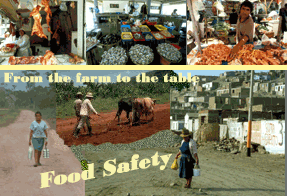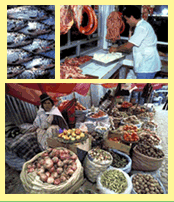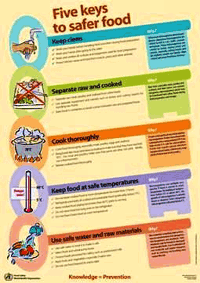PAHO Regional Program on Food Safety:
Working to Prevent and Control Food-Borne Diseases

Mission: To promote an environment that makes it possible for the health sector, in cooperation with other sectors and partners, to evaluate, communicate, and handle risks associated with food-borne hazards.
Objective: To reduce the impact on health-be it social or economic-associated with the occurrence of water-borne and food-borne diarrheal diseases, as well as with the presence of microbiological and chemical hazards in food.
Areas of Work
- Risk Assessment
- Strengthening surveillance in countries, including their response capacity and involvement in international networks, as part of food safety and monitoring food hazards.
- Developing national and local training courses to improve the acquisition, analysis, and use of information for the epidemiological characterization of problems related to a lack of safety, with a systematic approach "from the farm to the table," as well as improving response capability in emergencies and disasters.
- Providing a better definition of the burden of food-borne diseases, which has not been well defined in the countries of the Region. Continuing to coordinate, in coordination with national public health authorities, international activities designed to help the countries strengthen their disease surveillance systems and determine the disease burden of acute gastroenteritis. Using these data to evaluate the burden of disease associated with acute food-borne gastroenteritis, specific food-borne pathogens, and specific food groups.

- Risk Management
- Improving the countries' capability to handle food safety risks through the use of systematic risk assessment and developing integrated food safety programs.
- Training in the application of systems for good agricultural and manufacturing practices, including standard operating procedures for sanitation and Hazard Analysis Critical Control Points (HACCP), with emphasis on small and medium-sized industries.
- Updating and harmonizing food safety legislation using experiences from the countries of the English-speaking Caribbean and the Southern Cone and the use of the Regional Information System on Food Legislation (LEGALIM).
- Supporting active country involvement in the Codex Alimentarius, in coordination with the Food and Agricultural Organization of the United Nations (FAO) and WHO, through the FAO Trust Fund for Food Security and Food Safety.
- Risk Communication and Education
- Improving national capacities to maintain the communication flow with and among the public and private sectors in the area of food safety, through adapting, validating, and adopting the manual for the application of the Five Keys to Food Safety in schools, markets, and communities, particularly in the priority countries and in the most unprotected communities.
- Consolidating the International Food Safety Authorities Network (INFOSAN), in coordination with FAO and WHO, and routinely reporting to the official Focal Points and Points of Contact designated by the national authorities on relevant food safety problems at the global level.
- Focal Strategy
Mobilizing and optimizing the use of resources—be they regular internal resources within the organization and the countries, from extra-budgetary sources, or the result of strategic collaboration with Member States and other international organizations—for the following:- Collaborating with national governments to develop studies on the burden of disease.
- Improving institutional capacity and technical capability and developing leadership in public health surveillance for diseases commonly transmitted through food.
- Creating associations, partnerships, and effective interactions with agencies within the United Nations and Organization of American States (OAS) systems, as well as with National Organizations of Public Health and the private sector to achieve the implementation of sustainable food safety policies.
- Strengthening links between the health and livestock sectors to ensure that food safety interventions be planned and carried out in an integrated fashion "from the farm to the table."
- Improving the institutional capacity and technical capability to implement systematic approaches and adopt scientific evidence-based decisions such as systematic revisions, meta-analysis, and risk analysis.

Main Program Website:
Food Safety |
Inocuidad de los Alimentos
About the Veterinary Public Health Unit | Sobre la Unidad de Salud Pública Veterinaria
WHO Food Safety Page | Página OMS sobre Inocuidad de los Alimentos